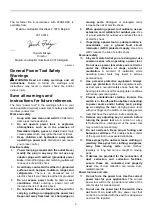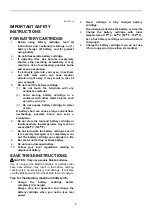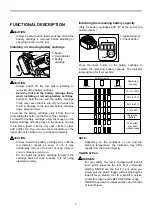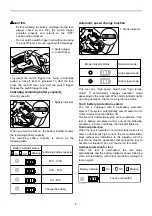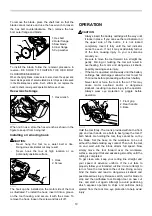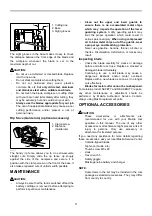
5
Kickback is the result of tool misuse and/or incorrect
operating procedures or conditions and can be avoided
by taking proper precautions as given below.
9.
Maintain a firm grip with both hands on the
tool and position your arms to resist kickback
forces. Position your body to either side of
the blade, but not in line with the blade.
Kickback could cause the tool to jump backwards,
but kickback forces can be controlled by the
operator, if proper precautions are taken.
10.
When blade is binding, or when interrupting a
cut for any reason, release the trigger and
hold the tool motionless in the material until
the blade comes to a complete stop. Never
attempt to remove the tool from the work or
pull the tool backward while the blade is in
motion or kickback may occur.
Investigate and
take corrective actions to eliminate the cause of
blade binding.
11.
When restarting a tool in the workpiece,
center the blade in the kerf and check that
blade teeth are not engaged into the material.
If blade is binding, it may walk up or kickback
from the workpiece as the tool is restarted.
12.
Support large panels to minimise the risk of
blade pinching and kickback.
Large panels tend
to sag under their own weight. Supports must be
placed under the panel on both sides, near the line
of cut and near the edge of the panel.
13.
Do not use dull or damaged blades.
Unsharpened or improperly set blades produce
narrow kerf causing excessive friction, blade
binding and kickback.
14.
Blade depth and bevel adjusting locking
levers must be tight and secure before
making cut.
If blade adjustment shifts while
cutting, it may cause binding and kickback.
15.
Use extra caution when making a "plunge cut"
into existing walls or other blind areas.
The
protruding blade may cut objects that can cause
kickback. For plunge cuts, retract lower guard
using retracting handle.
Lower guard function
16.
Check lower guard for proper closing before
each use. Do not operate the tool if lower
guard does not move freely and close
instantly. Never clamp or tie the lower guard
into the open position.
If tool is accidentally
dropped, lower guard may be bent. Raise the
lower guard with the retracting lever and make
sure it moves freely and does not touch the blade
or any other part, in all angles and depths of cut.
17.
Check the operation and condition of the
lower guard spring. If the guard and the
spring are not operating properly, they must
be serviced before use.
Lower guard may
operate sluggishly due to damaged parts, gummy
deposits, or a buildup of debris.
18.
Lower guard may be retracted manually only
for special cuts such as "plunge cuts" and
"compound cuts". Raise lower guard by
retracting handle and as soon as blade enters
the material, the lower guard must be released.
For all other sawing, the lower guard should
operate automatically.
19.
Always observe that the lower guard is
covering the blade before placing tool down on
bench or floor.
An unprotected, coasting blade will
cause the tool to walk backwards, cutting whatever
is in its path. Be aware of the time it takes for the
blade to stop after switch is released.
20.
To check lower guard, open lower guard by
hand, then release and watch guard closure.
Also check to see that retracting handle does
not touch tool housing.
Leaving blade exposed
is VERY DANGEROUS and can lead to serious
personal injury.
Additional safety warnings
21.
Do not stop the blades by lateral pressure on
the blade.
22.
DANGER:
Do not attempt to remove cut material when
blade is moving.
CAUTION: Blades coast after turn off.
23.
Place the wider portion of the tool base on
that part of the workpiece which is solidly
supported, not on the section that will fall off
when the cut is made.
24.
Never attempt to make a cut with the tool held
upside down in a vise. This is extremely
dangerous and can lead to serious accidents.
25.
Wear safety goggles and hearing protection
during operation.
26.
Do not use any abrasive wheels.
27.
Only use the blade with the diameter that is
marked on the tool or specified in the manual.
Use of an incorrectly sized blade may affect the
proper guarding of the blade or guard operation
which could result in serious personal injury.
SAVE THESE INSTRUCTIONS.
WARNING:
DO NOT let comfort or familiarity with product
(gained from repeated use) replace strict adherence
to safety rules for the subject product. MISUSE or
failure to follow the safety rules stated in this
instruction manual may cause serious personal
injury.



